How to Create Your Dating App in 8 Easy Steps
 By
By Share
 By
By Share

Dating apps have transformed how people connect and form relationships, making them an increasingly popular and lucrative industry. Apps like Tinder, Bumble, and Hinge have set the standard by offering unique features and seamless user experiences.
However, the growing demand for niche and innovative platforms means there’s plenty of room for new players in the market. Creating a dating app requires creativity, technical expertise, and strategic planning.
This is where we stand out. We at Tenet have developed 3 large-scale dating apps, which has helped us develop a tried-and-tested method for creating a dating app.
Do you also want to know how to start an online dating service?
Before you start, learn about how much SaaS app development costs.
How to Create Your Own Dating App?
Creating a dating app involves several steps, from planning and designing to developing and marketing the app.
Below are the detailed steps to help you create a dating app:
Step 1: Research About Similar Dating Apps
When considering the purchase of a new phone, you typically conduct basic research on the available options. Creating a dating app from scratch requires a similar approach but on a much deeper level. Conducting thorough market research is essential before making any decisions.
Here are the key questions to consider when researching dating apps:
- Who is your target audience?
- What percentage of the market is occupied by dating apps?
- Which dating apps are trending and performing well in your region?
- What market opportunities exist for dating apps?
- Why are apps like Tinder and Bumble so popular? What features make them stand out?
Exploring these questions will give you a solid foundation for understanding the dating app development market. For instance, defining your target audience will help you decide whether to create an app for a general audience or focus on a specific niche, such as the LGBTQ+ community.
This clarity will also help you pinpoint unique features to incorporate into your app. Keep in mind that the features of a dating app like Tinder or Bumble will differ from those of an app like Grindr.
Additionally, we’ve included three online market research tools to help you analyze the dating app market in detail.
A. Google Trends
Analyze search interest for terms like "dating apps" or specific app names over time and across regions. Identify trends, compare competitors, and target high-demand areas.
Here is an example of how you can use Google Trends to conduct market research. The screenshot below shows the search interest of two keywords, "dating app" and "online dating," which will help you understand if people are still interested in it.
B. Answer the Public
Discover common user questions and frustrations about dating apps to uncover pain points and generate feature ideas or marketing content.
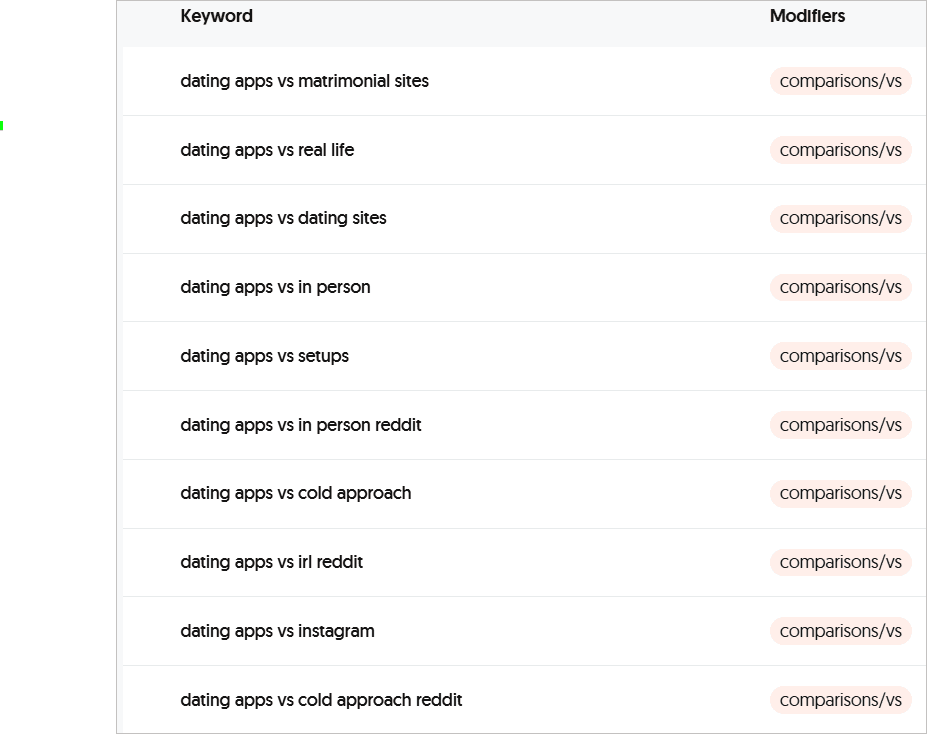
C. Think With Google
Access consumer behavior trends, market reports, and case studies to understand user preferences and shape your app's strategy.
These tools help identify trends, user needs, and market opportunities for developing a successful dating app.

Step 2: Understand What Works in the Dating App Industry and Identify the Niche
Before investing extensive time in developing features for a dating app, take a moment to list the essential functionalities. Additionally, analyze major dating platforms like Tinder and Bumble to understand the basic features they offer. Keep the following points in mind while researching the dating app industry:
- Research your niche
- Identify the USP (Unique Selling Proposition) of the platform
- Find loopholes and problems you can address to create a better app than what’s already existing in the market
If your goal is to help users find the right partner, researching niche-specific dating apps is crucial. Apps like Ashley Madison and Match show how niche-focused platforms are flourishing due to positive user responses. Consider the following apps and their standout features:
These examples illustrate the range of features successful apps use to meet their target audiences' needs. By analyzing these apps, you can better understand what works and develop a dating app that provides a relevant and satisfying experience for users.
Step 3: Analyze Your Competitors
When creating a dating app, it’s essential to consider the loopholes and problems that the current apps face in this industry. Thus, to make your dating app successful, focus on strategies to reduce uninstallation rates.
Understanding what competitors are doing to boost their app retention rates is crucial. Use this 7-step method for competitor analysis:
- Identify Top Apps: List the leading dating applications and install them.
- Explore Thoroughly: Navigate each app to study its features and user experience in detail.
For example, Hinge is a dating app designed for individuals seeking meaningful, long-term relationships rather than casual hookups. Its tagline, "Designed to be deleted," emphasizes its focus on helping users find lasting connections.
Hinge asks users to ask questions to create engaging profiles. The profile also showcases personal insights, photos, and preferences, making it easier to find compatible matches.
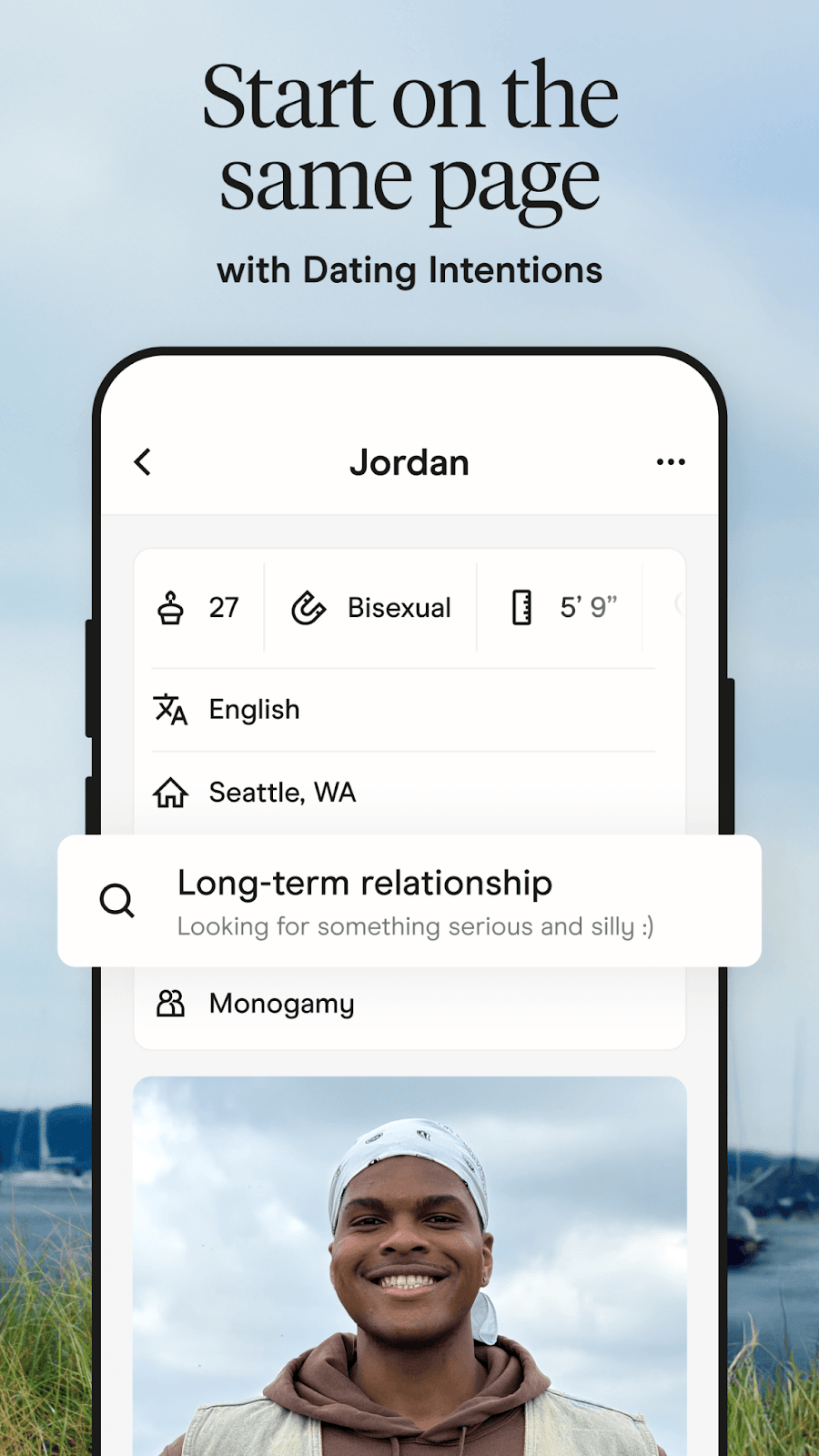
- Read Reviews: Analyze user feedback to understand what they like or dislike.
For instance, you can read reviews and ratings related to the Hinge app on Google Play Store and App Store. Here is a screenshot of Hinge's rating on the Google Play Store.
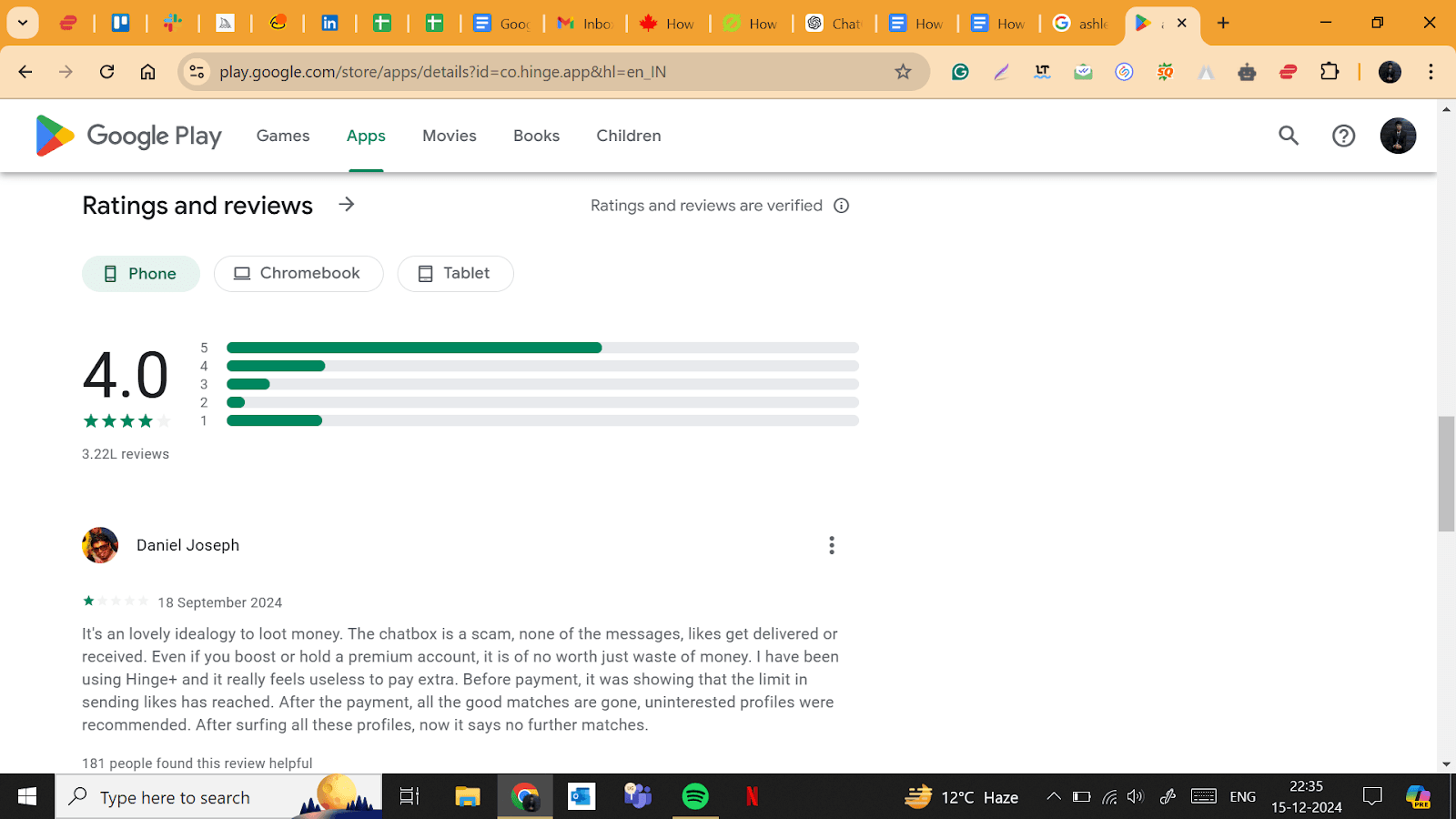
- Take Notes: Record the features and elements you want to include in your app.
- Identify Top Features: Highlight the standout features of the best apps.
- Finalize Features: List the features you will integrate into your app.
- Track Trends: Research current trends in the dating app industry.
Finally, identify the Unique Selling Propositions (USPs) of your competitors. After thorough market analysis, define your app’s unique value proposition to stand out in the market.
Step 4: Define Your Unique Value Proposition
To stand out from competitors, your dating app must have a well-defined unique selling point (USP). Establishing a USP not only gives you a competitive edge but also clarifies the vision and benefits your app offers to users. Here are some ways to identify your app’s USP:
- Decide if your goal is to enhance the overall user experience in your dating app.
- Focus on improving match quality through a robust and intelligent algorithm.
- Choose to target a specific niche to cater to unique audience needs.
- Commit to creating a dating app that is completely free from fake profiles to build user trust.
Here’s a list of popular dating apps, their USPs, and download statistics from the Google Play Store to inspire your approach:
Drawing inspiration from successful apps can help you create a competitive and compelling dating platform.
Step 5: Identify the Exact Specifications
To recap, you’ve researched existing dating apps and identified the factors that drive their success. The key to retaining users is engagement—if users delete the app without meaningful interaction, you risk losing them.
Now, let’s focus on defining the exact specifications to maximize user engagement. Align these specifications with your business goals:
- App Development Approach: Should you create a native app for optimal performance or a hybrid app for broader compatibility?
- Unique Offerings: What unique features or specifications will set your app apart from competitors?
- Target Audience: Will you aim for a broad user base or focus on a niche dating app?
- Monetization Strategy: Which strategy will you implement—subscriptions, ads, or in-app purchases? Your specifications should align with this strategy.
Answering these questions is crucial for creating a dating app tailored to your business objectives. For monetization, consider integrating features like in-app purchases to boost revenue and enhance user experience.
Step 6: Focus on the UI/UX of the App
With the essential features for your mobile application outlined, the next step is designing an appealing and user-friendly interface. The goal is to ensure your app looks attractive and is easy to navigate.
For instance, Tinder’s UI/UX is renowned for its simplicity and smooth functionality. Users can effortlessly swipe right or left to accept or reject profiles, switch from swiping to messaging seamlessly, and view who has super-liked them without delays.
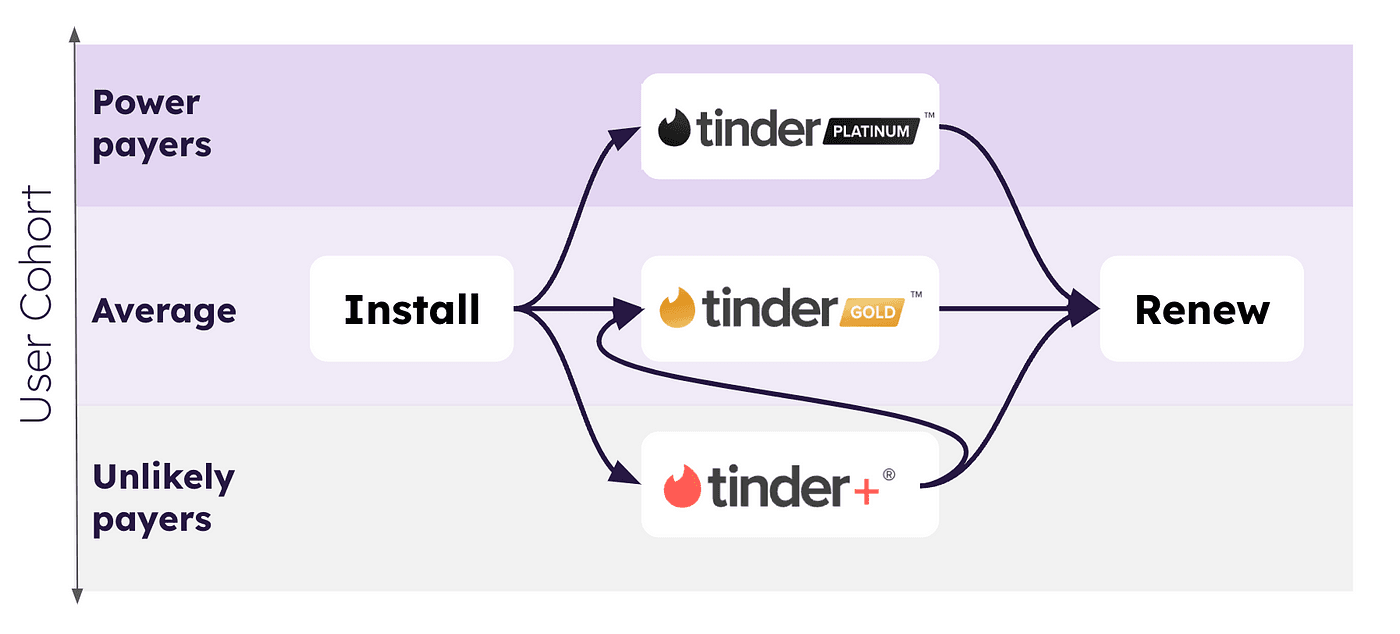
Such intuitive designs have contributed to the revenue success of companies like Tinder and Bumble.
To achieve similar results, professional UI/UX designers at Tenet use advanced tools to create prototypes for dating apps.
At Tenet, we prioritize UI/UX design because it plays a pivotal role in an app's success.
Step 7: Focus on the UI/UX of the App
Once the SaaS UI/UX design is completed, the next phase is the development of the dating app. Building an MVP (Minimum Viable Product) version allows you to test the app in the market, gather feedback, and begin building a user base.
Initially, focus on including only the essential features necessary for your app’s launch.
A key feature to include in the development of a successful dating app is a robust matching algorithm. The question arises—how do two users get matched when they swipe left or right?
Here are four important functions to consider when building an effective matching algorithm using modern technologies like Artificial Intelligence:
The reason for choosing the MVP version is to collect valuable feedback from early users, allowing you to make improvements and increase user retention. By developing the MVP first, you can stay user-focused, collect insights, and refine your app before releasing the full version.
We at Tenet can help create an app that aligns with your business goals and adds unique value— learn more about our UI UX design services and get a free proposal.
Step 8: Test and Deploy Your app
After successfully integrating all the features into your dating app, the next crucial step is testing. Since bugs are common during the development process, it’s essential to conduct thorough mobile app testing before launching your app. Perform tests such as API testing, registration, login, and match testing to identify and fix any errors.
Additionally, test your user-matching algorithms to ensure profiles match under the correct conditions. If your app includes in-app purchases, integrate a reliable payment gateway, like Stripe or PayPal, and test the payment process to ensure everything works smoothly.
Once testing is complete, it’s time to deploy your dating app to the Google Play Store and Apple App Store. Before submission, make sure to follow the respective guidelines for each platform.
How Much Does it Cost to Build a Dating App?
The cost of building a dating app ranges between $5,000 and 50,000+. A simple MVP dating app with basic features like profiles, matching, and chat may cost $5,000 to $25,000, while a more advanced app with additional functionality could range from $80,000 to over $100,000.
The cost of building a dating app can depend on various factors, such as features and functionality, design complexity, development platform, technology stack, team composition, geographical location, and testing and maintenance.
What Factors Affect the Cost of Building a Dating App?
Before creating a dating app, it is essential to consider the cost of building one. Several essential factors that influence the overall budget.
From conceptual design to the app’s official launch, it contributes to the final expenditure. Below are the key elements that have a substantial impact on development costs:
1. Type and the Size of the app
The type and size of a dating app are crucial factors that directly influence its development cost. They determine the level of complexity, features, and resources required, all of which contribute to the overall expenses.
The type of app refers to its scope and functionality, which significantly impacts the budget. For example, a Minimum Viable Product (MVP) is designed to include only essential features like user profiles, basic matching, and messaging. This makes it faster and cheaper to develop, typically appealing to startups or those testing a concept.
In contrast, a feature-rich app includes advanced functionalities like AI-based matching, geolocation, video calls, subscription models, and in-app purchases. Developing such an app requires more time, advanced technology, and specialized expertise, leading to higher costs.
The number of features determines the size of the app, the target user base, and the level of customization. Small-scale apps cater to a specific niche audience with limited features, making them more affordable and less complex to build.
On the other hand, large-scale apps aim to serve a broad audience, often requiring high scalability, robust back-end infrastructure, and comprehensive feature sets.
2. Features and Functionalities
The features and functionalities of a dating app are among the most significant factors influencing its development cost.
Each feature requires design, coding, integration, and testing, which adds to the complexity and, subsequently, the expenses.
Here’s how specific aspects impact the overall cost:
Here is a table showcasing the cost of adding various features to your dating app:
3. UI/UX Design
UI/UX design plays a crucial role in determining the cost of dating app development. The design directly affects user satisfaction, engagement, and retention, which makes it an essential component of the development process.
A well-thought-out UI (User Interface) and UX (User Experience) design can elevate the app’s appeal, making it intuitive and easy to use. On the other hand, poor design can lead to user frustration and, ultimately, higher costs in terms of revisions, user dissatisfaction, and loss of engagement.
For example, Tinder’s UI/UX is simple, intuitive, and engaging, centered around swipe gestures for quick matchmaking. Its minimalist design, streamlined onboarding, and interactive profile cards create a seamless experience, while features like mutual match chat and premium options enhance usability and engagement.
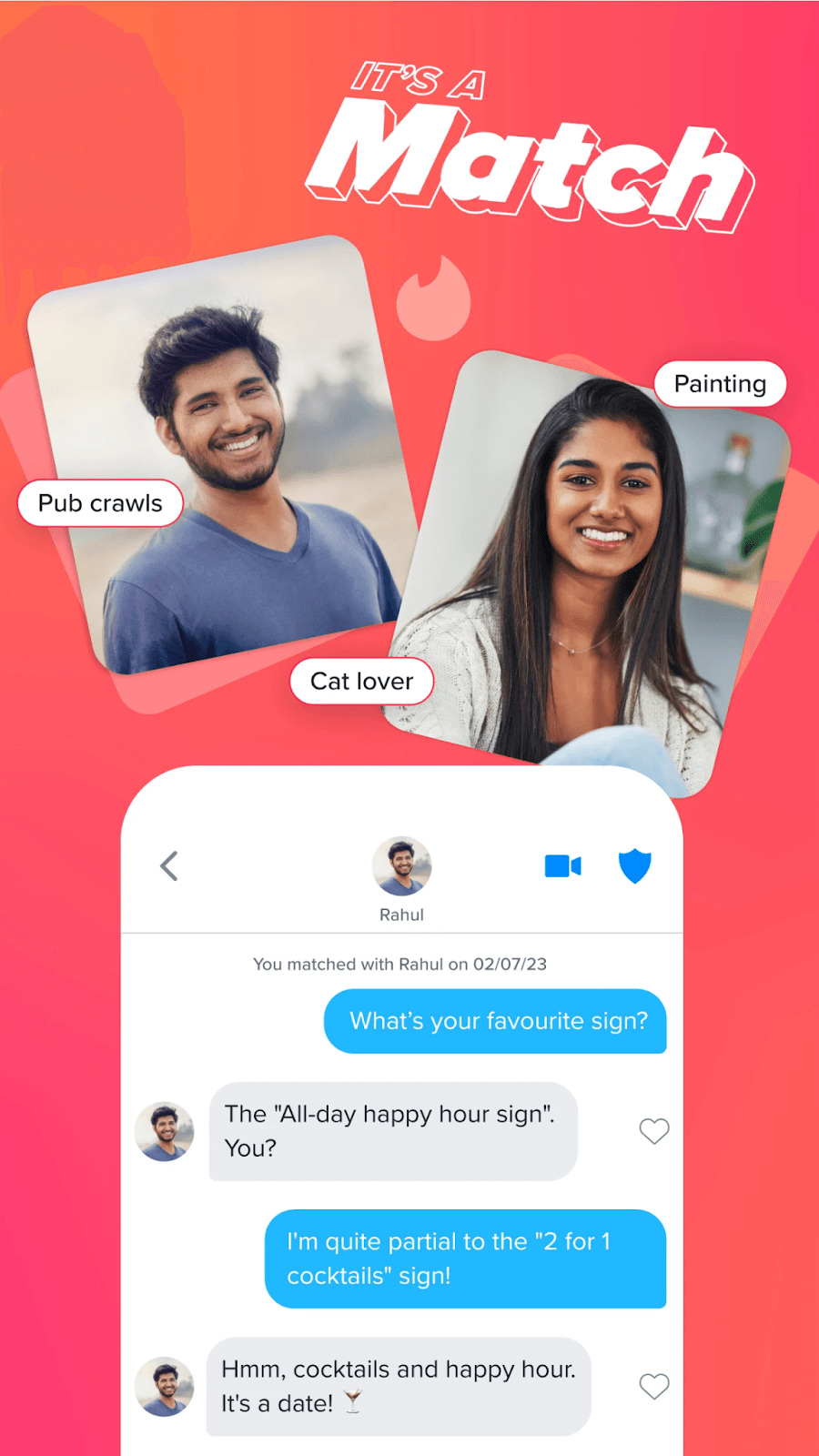
What are the Common Revenue Models for Dating Apps?
Dating apps use a range of revenue models to earn income while offering users engaging experiences. Below are the most common monetization strategies used by these platforms:
1. Freemium Subscription Model
The Freemium Subscription model allows dating apps to offer basic features for free, attracting a large user base. By providing these free features, apps engage a wide audience and then monetize by offering premium features.
Premium features can include unlimited swipes, advanced filters, or the ability to see who has liked their profile. This model capitalizes on user engagement, transforming it into a reliable revenue stream for the app.
For Example: Tinder offers basic features for free, allowing users to create profiles, swipe, and match with other users.
However, premium features such as Tinder Plus and Tinder Gold offer perks like unlimited swipes, the ability to see who liked your profile, and the option to swipe in different locations. These premium features entice users to upgrade, helping Tinder generate revenue from its large user base.
2. Paid Subscription Model
In the Paid Subscription model, users pay upfront to access the full range of features on the dating app. This model generates consistent, recurring revenue as users subscribe for exclusive benefits, such as enhanced profile visibility and priority matching.
The steady income from these subscriptions helps the app maintain its operations and continue providing premium features. This model illustrates how dating apps can make money through continuous user investment.
For Example: Bumble operates on a paid subscription model where users pay upfront for premium access through subscriptions like Bumble Boost or Bumble Premium. These paid plans provide exclusive benefits like advanced filters, seeing who’s already swiped right on you, and extended matches.
By charging a subscription fee, Bumble secures consistent, recurring revenue, which supports its continued development and premium features.
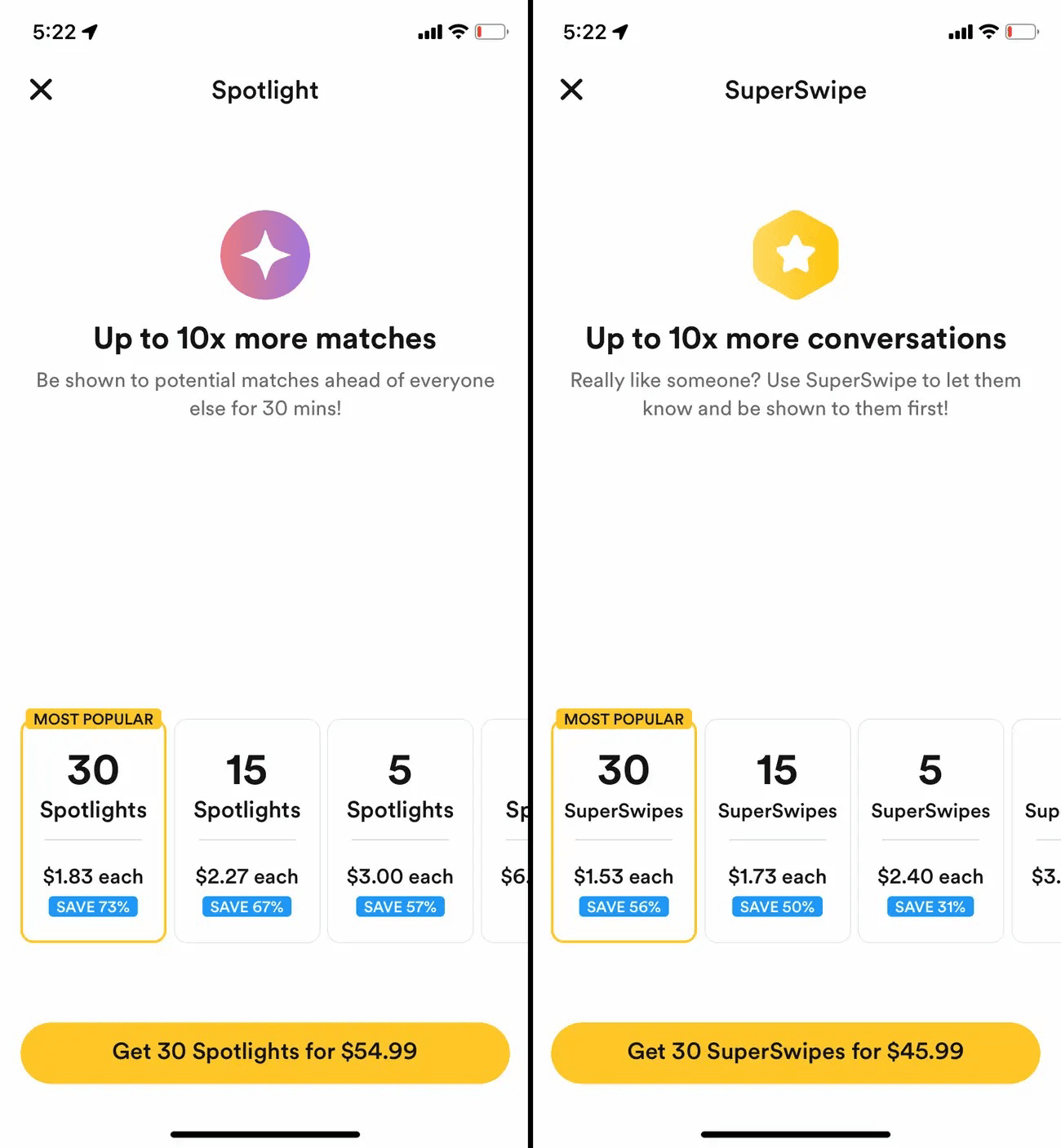
3. VIP Membership
The VIP Membership model is a targeted strategy that provides users with premium features, such as increased profile visibility, unlimited messaging, and priority responses. By catering to users willing to pay for exclusivity, this approach ensures consistent revenue and fosters loyalty among high-value subscribers.
As a result, businesses can increase profitability and improve retention, maximizing the long-term success of the app.
For Example: EliteSingles targets users looking for serious relationships and offers a VIP Membership with premium features like increased profile visibility, unlimited messaging, and priority customer support.
VIP members also receive access to exclusive matchmaking features, ensuring a more personalized experience. This model generates consistent revenue from users who are willing to pay for exclusivity, driving loyalty and long-term profitability.
Should you Hire a Freelancer or an app Development Agency to Build Your Dating App?
Several factors come into play when deciding whether to hire a freelancer or an app development agency to build your dating app.
Each option has its advantages and disadvantages, which can significantly impact the success and efficiency of your project.
Pros and Cons of Hiring a Freelancer
Advantages
- Cost-Effectiveness: Freelancers usually charge lower rates than agencies, making them a cost-effective choice for startups or small projects with tight budgets.
- Specialization: Many freelancers have expertise in specific areas (e.g., UI/UX design, backend development), which can be valuable for specialized tasks.
- Flexibility: Freelancers often offer more flexible working arrangements, enabling direct communication and rapid adjustments based on feedback.
Disadvantages
- Limited Resources: Freelancers may lack the resources to manage complex projects requiring a diverse skill set, which could lead to delays or quality concerns. It is usually not possible for 1 freelancer to conduct UX research, create UI designs, do development for the application, create the website, do QA testing, and deploy the app. It takes multiple different individuals of varying expertise to create a holistic solution.
- Project Management: You may need to take on the role of project manager, overseeing various aspects of the development, which can be time-consuming and needs you to be a technical expert in that subject matter.
- Scalability Issues: If the app grows (which is the aim of any such project) or requires additional features, a freelancer will generally struggle to scale their services as effectively as an agency with multiple resources.
Pros and Cons of Hiring Tenet for Your Dating app Development
Advantages
- Comprehensive Skill Set: Agencies typically employ a team of professionals with diverse expertise (e.g., developers, designers, project managers), offering a more complete approach to app development.
- Timely Delivery: With multiple team members working in parallel, tenet is able to deliver projects faster than freelancers who work independently and are experts in one a handful of skills.
- Ongoing Support: Agencies typically offer post-launch support and maintenance, ensuring your app remains functional and is updated as needed.
Disadvantages
- Higher Costs: Cost of hiring Tenet can be more than the cost of hiring a freelancer, due to Tenet’s team size and expertise —which can be a major factor for really small projects but in longer run the quality they offer overshadows the cost. This makes it economical in a long run.
- Less Direct Control: Communication may be less direct with individual team members, which can sometimes lead to misunderstandings about project requirements.Tenet takes care of this by ensuring weekly sync meetings with your project success manager, and regular updates to ensure there are no surprises, and communication is at it’s best.
- Potential Overhead: Agencies may have additional costs, such as administrative or project management fees, which could be passed on to you if your project’s scale requires these services.
How Much Does it Cost to Make an App Like Bumble and Tinder?
The cost to make an app like Bumble and Tinder ranges between $25,000 and $120,000, depending on the complexity of the features, design, and hourly rates of the development team, as well as their location.
Below is a general breakdown:
- Basic Version (MVP): A simple dating app with core functionalities such as user profiles, matching, and chat can cost between $25,000 and $50,000. This range typically covers essential features and a minimalistic design.
- Medium-Complexity Version: For a more feature-rich app that includes functionalities like geolocation, advanced matching algorithms, and social media integration, the costs can escalate to $80,000 to $120,000. This includes additional development time and resources.
- Advanced Version: A complex dating app with extensive features (e.g., video calling, premium subscriptions) can exceed $120,000, with some estimates suggesting costs could reach up to $1 million when considering ongoing enhancements and infrastructure needs for large user bases.
Here’s a rough estimate of costs associated with different phases of app development:
Are Dating Apps Expensive to Run and Maintain?
Yes, dating apps can be expensive to run and maintain due to several ongoing costs. These include:
1. Server and Hosting Costs
Hosting user data, managing real-time messaging, and supporting millions of active users require robust servers, leading to substantial monthly expenses.
2. Maintenance and Updates
Regular updates are needed to fix bugs, introduce new features, and keep the app compatible with evolving operating systems and devices.
3. Customer Support
Providing user assistance, moderating content, and handling disputes require a dedicated support team.
4. Marketing and User Acquisition
Consistent marketing campaigns to attract and retain users significantly add to operational costs.
5. Security and Compliance
Ensuring user data protection, complying with privacy regulations, and preventing fraud or misuse are critical, often requiring advanced tools and expertise.
While the exact costs vary, running a successful dating app involves significant ongoing investment to ensure seamless functionality and user satisfaction.
How Long Does it Take to Create a Dating App From Scratch?
It takes about 4 to 12 months to create a dating app from scratch. Here’s a detailed breakdown of the timeline based on different aspects of the development process:
Various factors can impact the cost of creating a dating app from scratch. Some of the major ones include the following:
- Feature Complexity: The more advanced the features, the longer the development time.
- Platform Choice: Building for both iOS and Android takes more time than focusing on a single platform.
- Design Customization: Unique and interactive designs require additional time.
- Team Expertise: Experienced teams can streamline development compared to less experienced ones.
- Testing and Iterations: Identifying and fixing bugs or refining features can extend the timeline.
👉 Get cost break breakdown to develop iOS application.
What’s Next — Get a Free Quote From Dating app Development Experts at Tenet
Creating a dating app requires careful planning, strategic design, and seamless execution. From conducting market research to selecting the right features and technology stack, every step plays a crucial role in building a successful platform.
With the right approach, your app can not only connect users but also become a profitable and sustainable business venture. Additionally, by assembling a skilled development team, focusing on user-friendly design, and staying adaptable to user feedback, you can create a dating app that stands out in a competitive market.
So, if you are looking for an expert, then reach out to us.
Learn about our:
At Tenet, we have developed three successful dating applications, and we know the exact blueprint for assisting you.
Take the next step by getting a free quote from our dating app development experts. Contact our experts now!

Article By
Shantanu Pandey
Shantanu Pandey is a UI/UX design, branding, and growth marketing expert. As the Founder & CEO of Tenet, he helps global brands create amazing digital experiences.
Expertise Delivered Straight to Your Inbox
Expertise Delivered Straight to Your Inbox

Got an idea on your mind?
We’d love to hear about your brand, your visions, current challenges, even if you’re not sure what your next step is.
Let’s talk




















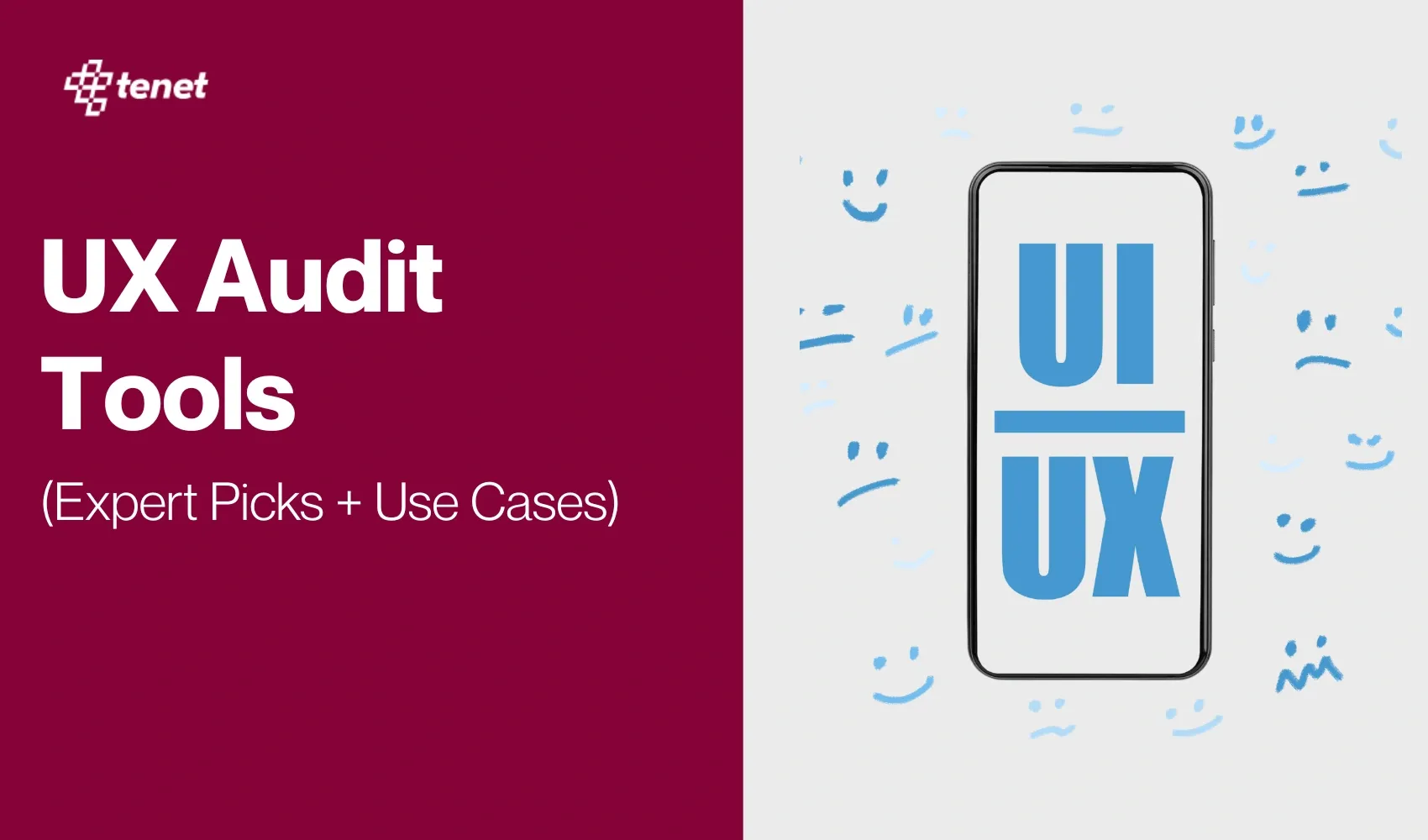











 U.A.E:
U.A.E: India:
India: UK:
UK: USA:
USA:
